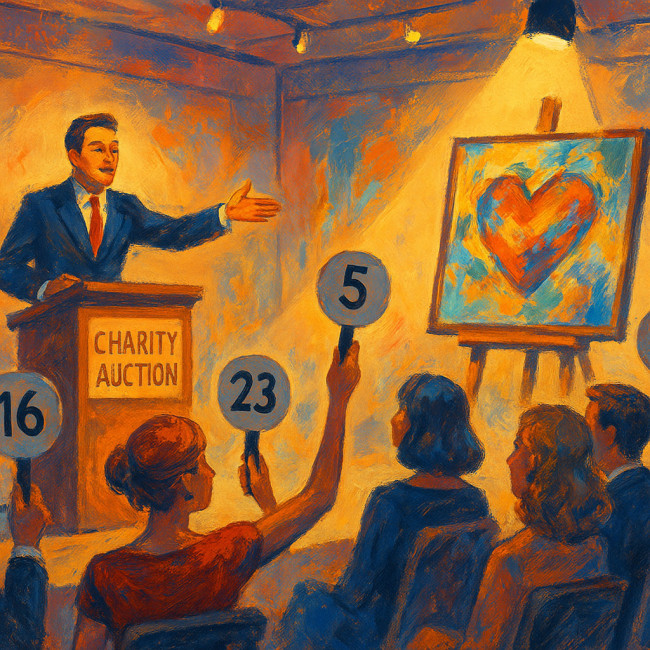Pricing artwork for charity auctions without underselling your creative value
Charity auctions boost visibility and raise funds, yet many artists walk away feeling they sold themselves short. This guide shows you how to set a price that honours your craft, supports the cause and protects long-term market value.
Why charity auctions require a distinct pricing strategy

Unlike commercial sales, charity events mix philanthropy, marketing and emotion. Bidders often pay more for goodwill, but organisers may push for low reserves to guarantee sales. You therefore need a method that balances both sides while signalling professionalism to curators, sponsors and future collectors. By articulating a fair reserve, you demonstrate that generosity and artistic rigor can happily coexist, encouraging higher bids without eroding long-term market credibility.
Key dynamics at play
- Perceived generosity: Donors equate low estimates with higher proceeds, yet undervaluing can erode your brand.
- Secondary-market ripple: Hammer prices become public data. Too low a sale can hurt future gallery negotiations.
- Tax implications: In many jurisdictions, only the fair market value (FMV) is deductible for donors—not the final bid.
Step-by-step framework to price artwork for charity auctions
1. Establish your current fair market value (FMV)
Compile recent sales of vergelijkbare works—gallery invoices, online platforms and private commissions. Average the prices, then adjust for size, medium and year. This number is your FMV baseline.
2. Select the right reserve price
Experts recommend 50–70 % of FMV for charity events. The reserve protects perceived value yet leaves room for emotionally driven bidding wars.
3. Present an anchor estimate
Work with organisers to publish a range—typically reserve to FMV. Clear framing prevents sticker shock and guides bidders toward realistic targets.
4. Offer value-add incentives instead of discounts
- Studio visit for the winning bidder.
- Signed exhibition catalogue.
- Certificate outlining provenance and care instructions.
These bonuses enrich the lot without lowering price.
5. Align with auction marketing timelines
Supply high-resolution images, concise bios and a narrative that links your work to the charity's mission. Early promotion attracts pre-bids and justifies stronger estimates.
Real-world pricing gaps: Charity vs. FMV
Source : Artnet Market Report
Checklist: Protect creative value before, during and after the auction
| Phase | Action | Why it matters |
|---|---|---|
| Pre-auction | Sign written agreement outlining reserve, promotion duties and unsold artwork handling. | Prevents last-minute pressure to lower price. |
| Event night | Attend or record a short video greeting. | Personal presence sparks competitive bidding. |
| Post-sale | Request final hammer price report and buyer details. | Ensures accurate CV entries and future authentication. |
Leveraging scarcity and licensing to elevate perceived worth
Limited editions, proper licensing and royalty clauses all reinforce value. For deeper tactics, explore our guide on royalty models for limited editions and discover how editioned print add-ons boost bidding excitement.
Negotiation tips with organisers
- Frame it as a win-win: A realistic reserve attracts serious collectors, which can drive bids beyond FMV.
- Offer staged donations: Pledge a fixed percentage of the hammer price above reserve. This reassures the charity yet protects your baseline.
- Cap additional fees: Agree on who covers framing, transport and catalogue design.
When organisers push for aggressive discounts, share market data or reference industry benchmarks available through specialist art-marketing reports to justify your stance.
Case study: Turning a charity sale into future commissions

Illustrator Maya Chen priced a large mixed-media piece at €2 000 reserve (70 % of FMV). The final bid reached €4 800. Instead of a simple hand-over, she included a studio tour voucher. Two attendees later booked bespoke murals worth €15 000. Her strategy mirrors outreach advice in our article on pricing permanent art installations for corporate spaces, proving that thoughtful post-sale engagement can convert charitable goodwill into lucrative, long-term relationships.
Common pitfalls and how to avoid them
- Blind donation: Handing over work without documentation. Always sign consignment forms.
- One-size reserve: Using flat €1 reserves to spark bids often backfires on unique artworks.
- Ignoring unsold clauses: Specify whether unsold pieces return to you or convert into a straight donation.
Mini-quiz: Are you pricing smartly for a charity auction?
FAQ
- Can I deduct the full hammer price on my taxes?
- Usually no. In many countries, artists can only deduct material costs or FMV. Consult a tax professional.
- What if my piece fails to reach the reserve?
- Include a clause that returns the artwork to you or lets you renegotiate donation terms after the event.
- How many pieces should I donate per year?
- Limit donations to avoid market saturation—two to three strategic events annually is acceptable for most mid-career artists.
- Should I sign the work before or after the sale?
- Sign beforehand; a signature authenticates the lot and reassures bidders.
Conclusion: Price with purpose, not fear
Charity auctions are powerful stages. When you anchor prices to FMV, craft compelling value-adds and negotiate clear terms, you amplify both the cause and your career. Ready to refine your pricing for the next event? Explore additional tactics in our guide on corporate gifting with artisanal pieces and position your art for maximum impact.
Take action: Download our free reserve-price calculator and enter your next charity auction with confidence.











